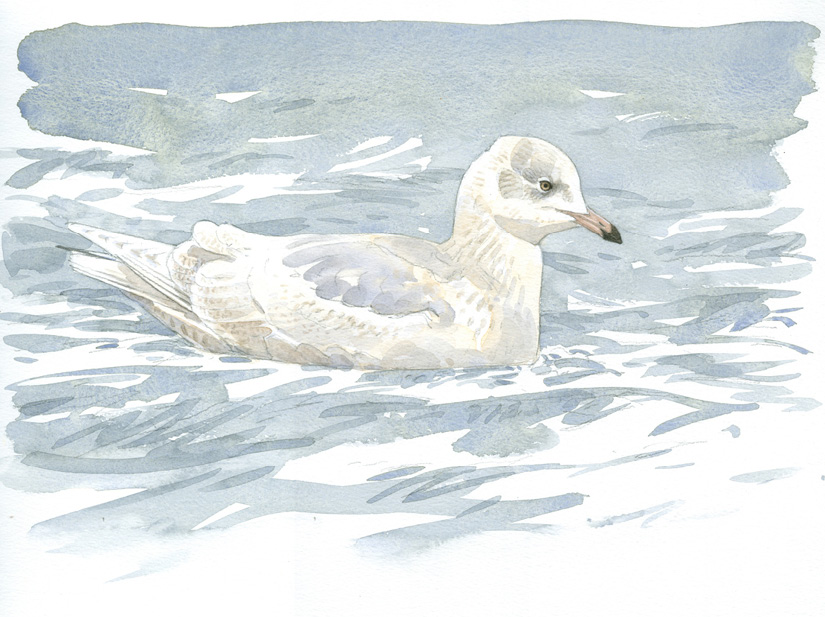Iceland Gull by Barry Van Dusen

Iceland Gull by Barry Van Dusen
An artist who has created many of our covers, Barry Van Dusen lives in Princeton, Massachusetts, and is well known in the birding world. Barry has illustrated several nature books and pocket guides, and his articles and paintings have been featured in Birding, Bird Watcher's Digest, and Yankee Magazine as well as Bird Observer. Barry's interest in nature subjects began in 1982 with an association with the Massachusetts Audubon Society. He has been influenced by the work of European wildlife artists and has adopted their methodology of direct field sketching. Barry teaches workshops at various locations in Massachusetts. For more information, visit Barry's website at http://www.barryvandusen.com.
Iceland Gull
The Iceland Gull (Larus glaucoides) is one of the world's most interesting and enigmatic gull species because its Arctic homeland makes it difficult to study. The variability in plumage and hybridization among the species' three subspecies makes identifying an individual to the subspecific level problematic. The nominate population of the Iceland Gull (L. g. glaucoides) is a "white-winged" gull that is smaller than a Herring Gull (L. argentatus). Most individuals of the race glaucoides lack gray on the wingtips. Adults have a light gray mantle and upper wing surface; immatures tend to be creamy brown as juveniles that turn whiter by their second year. The Kumlien's subspecies (L. g. kumlieni) is similar in all plumages, but has a highly variable amount of gray in the primary feathers, producing wing tips that vary from practically all white to dark gray, often making it hard to separate some of them from the Thayer's subspecies (L. g. thayeri), which has blackish wing tips. All subspecies have yellow bills with a red spot on the lower mandible and pink legs. Immatures have black bills.
Iceland Gull taxonomy has a long and confusing history. The Kumlien's Gull has, at one time or another, been considered a full species, and a subspecies of both Thayer's Gull and Iceland Gull. The Thayer's Gull also has been considered a full species, as well as a subspecies of both Herring Gull and Iceland Gull. In 2017, based upon twenty-first-century studies the American Ornithological Society lumped the Thayer's Gull with the Iceland and Kumlien's gulls to form a single species that retains the name Iceland Gull for all of the three races/species. How's that for confusing?
All three subspecies breed in coastal colonies in the Canadian Arctic Archipelago. The nominate Iceland subspecies breeds in eastern and southwestern Greenland. The Kumlien's subspecies breeds on the eastern half of Baffin Island. These two subspecies mainly winter in the North Atlantic, mostly in coastal southern Greenland and Iceland for glaucoides, and in eastern Canada and the northeastern United States for kumlieni, with a few wandering south along the United States coast to Virginia, and inland along the St. Lawrence waterway to the eastern Great Lakes. The Thayer's subspecies breeds in Buchanan Bay and the Arctic Islands of Nunavut, Canada, and winters along the west coast of Canada and the United States south to Baja California. In Massachusetts, wintering Iceland Gulls are considered uncommon to locally fairly common, with immature birds predominating. The Thayer's subspecies is considered a rare winter visitor.
The vocal array of Iceland Gulls is similar to that of the Herring Gull. A high-pitched laughing call signals dominance and may reflect a bird's place in the social hierarchy. They also utter a choking call at or near the nest, and barking calls before or during flight.
Iceland Gulls are presumed to be monogamous but little is known about courtship and pair formation. It is thought that they do not breed until after their fourth year but data are lacking. Little is known about territoriality or nest placement on densely packed cliff-face colonial nesting sites. Iceland Gulls often share nesting cliffs with Black Guillemots, other alcids, and Black-legged Kittiwakes. The nest selection process is unstudied. The nest material usually consists of loose, coarse vegetation and moss, often lined with feathers. The usual two to three eggs, laid in May or June, are gray or grayish-brown splotched with a variety of colors. Little is known about the nesting cycle, but both parents apparently develop brood patches and share incubation for the 24–26 days until hatching. The chicks are semiprecocial; they are covered with down and their eyes open soon after hatching. It is thought that the fledging period is 4–6 weeks. Little is known about the parents' role in feeding the chicks. In the fall, the independent young wander widely to the north or south. Whether Iceland Gulls are breeding-site faithful is unknown.
Iceland Gulls are opportunistic foragers. They are mainly surface feeders, and may take food in flight or while sitting on the water. They also regularly follow fishing boats. Their diet includes mainly fish, but they also take carrion, marine insects, other marine life, and the eggs of other birds. In winter they sometimes forage at garbage dumps with other gulls.
At breeding colonies, Gyrfalcons and Peregrine Falcons may prey on both adults and young Iceland Gulls, as may Glaucous Gulls, Common Ravens, and Arctic foxes. Historically, Iceland Gulls were harvested for their feathers and are still hunted for food by Inuits. Human impact is sometimes significant, particularly at breeding colonies, where the use of modern firearms, unenforced catch limits, and motorboats approaching nesting colonies may cause disruption. Oil spills have also been known to have a negative impact on Iceland Gulls. Despite these factors, the Iceland Gull is not considered threatened or endangered. Inaccessibility of many of the Arctic breeding colonies offers the Iceland Gull its best protection.
William E. Davis, Jr.